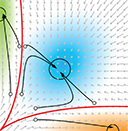Abstract
A revolution in cellular measurement technology is under way: For the first time, we have the ability to monitor global gene regulation in thousands of individual cells in a single experiment. Such experiments will allow us to discover new cell types and states and trace their developmental origins. They overcome fundamental limitations inherent in measurements of bulk cell population that have frustrated efforts to resolve cellular states. Single-cell genomics and proteomics enable not only precise characterization of cell state, but also provide a stunningly high-resolution view of transitions between states. These measurements may finally make explicit the metaphor that C.H. Waddington posed nearly 60 years ago to explain cellular plasticity: Cells are residents of a vast “landscape” of possible states, over which they travel during development and in disease. Single-cell technology helps not only locate cells on this landscape, but illuminates the molecular mechanisms that shape the landscape itself. However, single-cell genomics is a field in its infancy, with many experimental and computational advances needed to fully realize its full potential.
